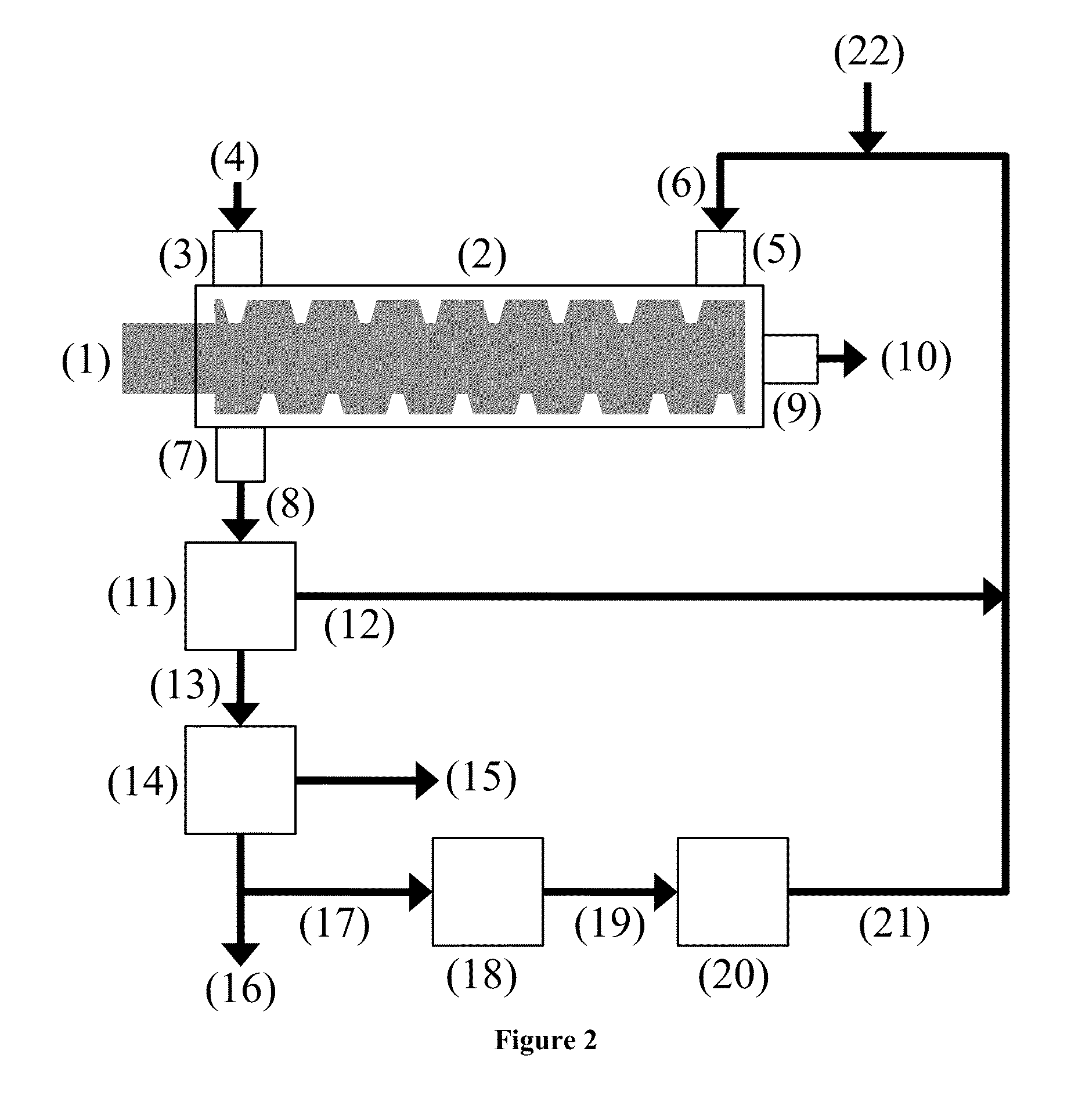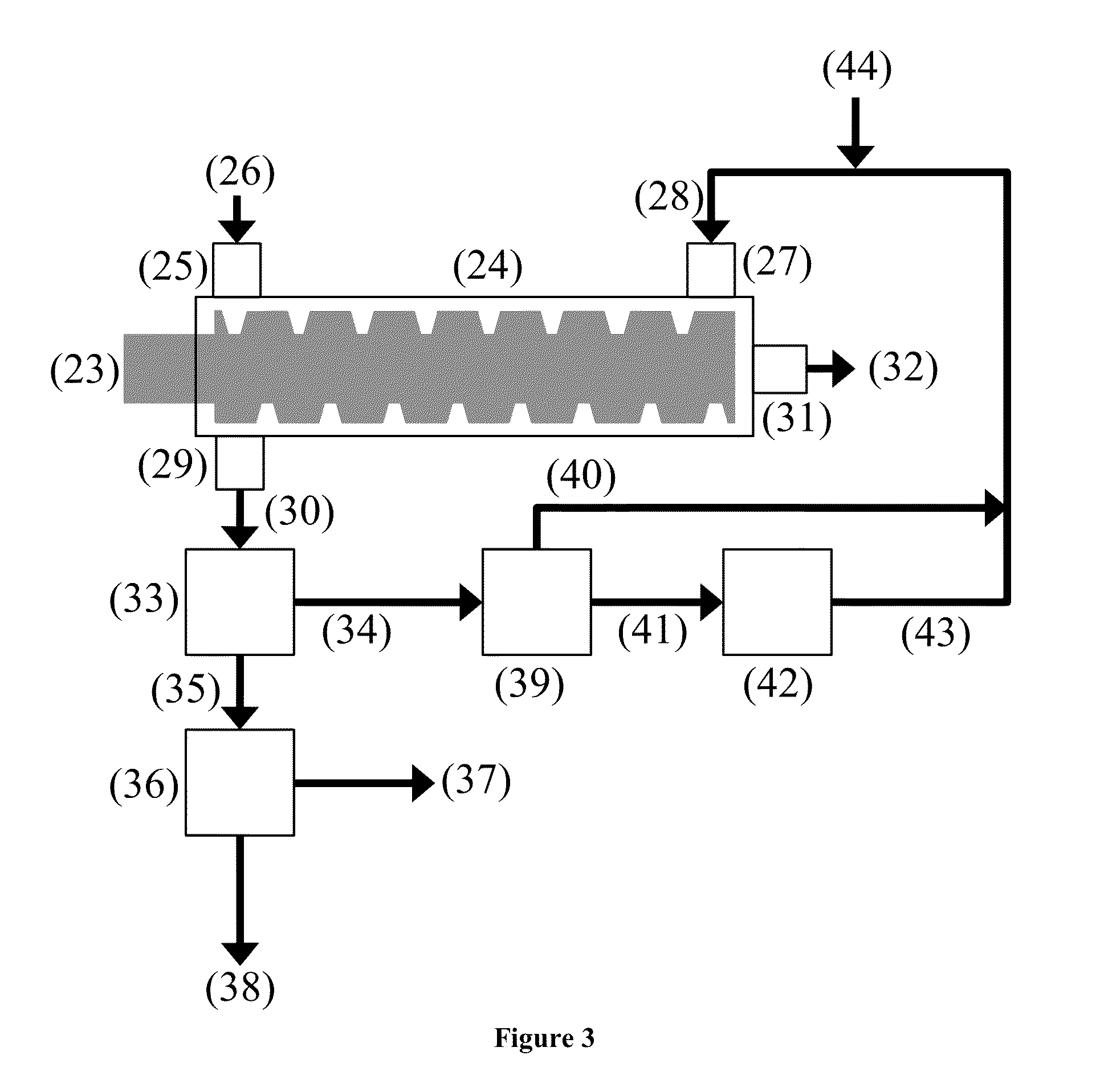Methods for producing sugars from biomass
a technology of biomass and sugar, applied in the field of biomass production methods, can solve the problems of difficult separation of cellulose from other biomass constituents, inability to effectively break down cellulose, etc., and achieve the effects of short residence time, short residence time, and reduced or even eliminated undesired side-product formation
- Summary
- Abstract
- Description
- Claims
- Application Information
AI Technical Summary
Benefits of technology
Problems solved by technology
Method used
Image
Examples
example 1
[0079]Corn cob feedstock comprising of 34.54% glucan, 28.65% xylan, 0.57% galactan, 3.33% arabinan, 16.9% Klason lignin with the remaining comprising of acetyl, inorganic ash, extractives and other components were used in a batch-type counter-current extraction apparatus called a flow-through shrinking-bed reactor. The batch-type apparatus allows bench-scale experimental simulation of a solids plug travelling through a continuous-type counter-current extraction apparatus subjected to counter flowing extraction fluid. In a series of experiments, approximately 36 g of corn cob were loaded into a custom-built flow-through plug-flow reactor with a spring-loaded movable plate that kept the cobs bed lightly compacted (i.e., not free-floating), thus the “shrinking-bed”. Continuous 80 mL / min flow of pH 1.1 acidic solution comprising of approximately 93.77% acetone, 6.22% water and 0.01% sulfuric acid were pumped through the reactor bed at increasing temperatures up to 220° C. to simulate th...
example 2
[0081]FIG. 2 illustrates one particular schematic embodiment of the invention. A counter current extraction apparatus (2) comprising of at least one material transporting element (1); a proximal inlet port (3) for introducing a first material or biomass feedstock (4); a distal fluid inlet port (5) for introducing a second material or an acidic solution (6) comprising primarily of acetone, water and sulfuric acid; a proximal outlet port (7) configured to allow recovery of the solution extract (8); and, a distal outlet port (9) configured to recover the recovered any solids residue (10) produced in the process. The solution extract (8) comprising primarily of sugars, lignin, other fluidized biomass products and components of the acidic solution undergoes reagent recovery (11) to produce recycled reagent (12) comprising primarily of acetone and water; and, an extract-rich solution (13) comprising primarily of sugars, lignin and other fluidized biomass products. The extract-rich solutio...
example 3
[0082]FIG. 3 is another schematic embodiment of the invention. A counter current extraction apparatus (24) comprising a material transporting element (23); a proximal inlet port (25) configured for introducing a first material or biomass feedstock (26); a distal fluid inlet port (27) configured for introducing a second material or acidic solution (28) comprising acetone, water and sulfuric acid; a proximal outlet port (29) is configured to recover the solution extract (30); and, a distal outlet port (31) is configured to recover any solids residue (32) produced in the reaction. The solution extract (30) comprising sugars, lignin, other fluidized biomass products and components of the acidic solution undergoes reagent recovery step (33) to produce a first recycled reagent (34) comprising acetic acid, acetone and water; and, an extract-rich solution (35) comprising sugars, lignin and other fluidized biomass products. The extract-rich solution (35) further undergoes lignin-sugar separa...
PUM
| Property | Measurement | Unit |
|---|---|---|
| pH | aaaaa | aaaaa |
| inlet temperature | aaaaa | aaaaa |
| pressure drop | aaaaa | aaaaa |
Abstract
Description
Claims
Application Information
 Login to View More
Login to View More - R&D
- Intellectual Property
- Life Sciences
- Materials
- Tech Scout
- Unparalleled Data Quality
- Higher Quality Content
- 60% Fewer Hallucinations
Browse by: Latest US Patents, China's latest patents, Technical Efficacy Thesaurus, Application Domain, Technology Topic, Popular Technical Reports.
© 2025 PatSnap. All rights reserved.Legal|Privacy policy|Modern Slavery Act Transparency Statement|Sitemap|About US| Contact US: help@patsnap.com



